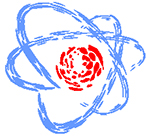Speaker
Ms
Elena Kruglyakova
(LRB)
Description
The most deleterious DNA lesions induced by ionizing radiation are clustered DNA double-strand breaks (DSB). Clustered DNA damage is a combination of a few simple lesions, within one or two DNA helix turns, created by the passage of a single radiation track. While the repair pathways of simple DNA lesions are sufficiently well studied, the mechanisms of clustered DNA damage repair haven’t yet been properly investigated.
For investigation of the induction and repair of clustered DNA lesions, human fibroblasts were irradiated with high-LET 11B (LET = 138 keV/μm, E = 8.1 MeV/n), 20Ne (LET = 132 keV/μm, E = 46.6 MeV/n), 15N (LET = 183.3, E = 13Mev/n) ions and low-LET 60Co γ-rays (LET ≈ 0.3 keV/μm) radiation. The proteins involved in DNA DSB (γH2AX/53BP1) and base damage (OGG1) repair form discrete foci at sites of damage and can be visualized by immunofluorecent microscopy technique. The obtained results show slower DSB elimination kinetics in cells irradiated with accelerated ions compared to 60Co γ-rays, indicating induction of more complex/clustered DNA damage. Confirming previous assumptions, detailed analysis of γH2AX/53BP1 foci in ions tracks revealed more complex structure of foci and increase in their size compared to γ-rays. It is shown, that the proteins 53BP1 and OGG1 involved in the DNA DSB repair and modified bases, respectively, are colocalized in tracks of 15N ions and represent thus clustered DNA lesions.
Primary author
Ms
Elena Kruglyakova
(LRB)
Co-authors
Dr
Alla Boreyko
(LRB, JINR)
Ms
Elena Smirnova
(JINR)
Ms
Lucie Jezkova
(Laboratory of Radiation Biology, Joint Institute for Nuclear Research)
Ms
Mariia Zadneprianetc
(JINR)
Ms
Tatyana Bulanova
(associate scientist, Joint Instituite for Nuclear Research, LRB)

